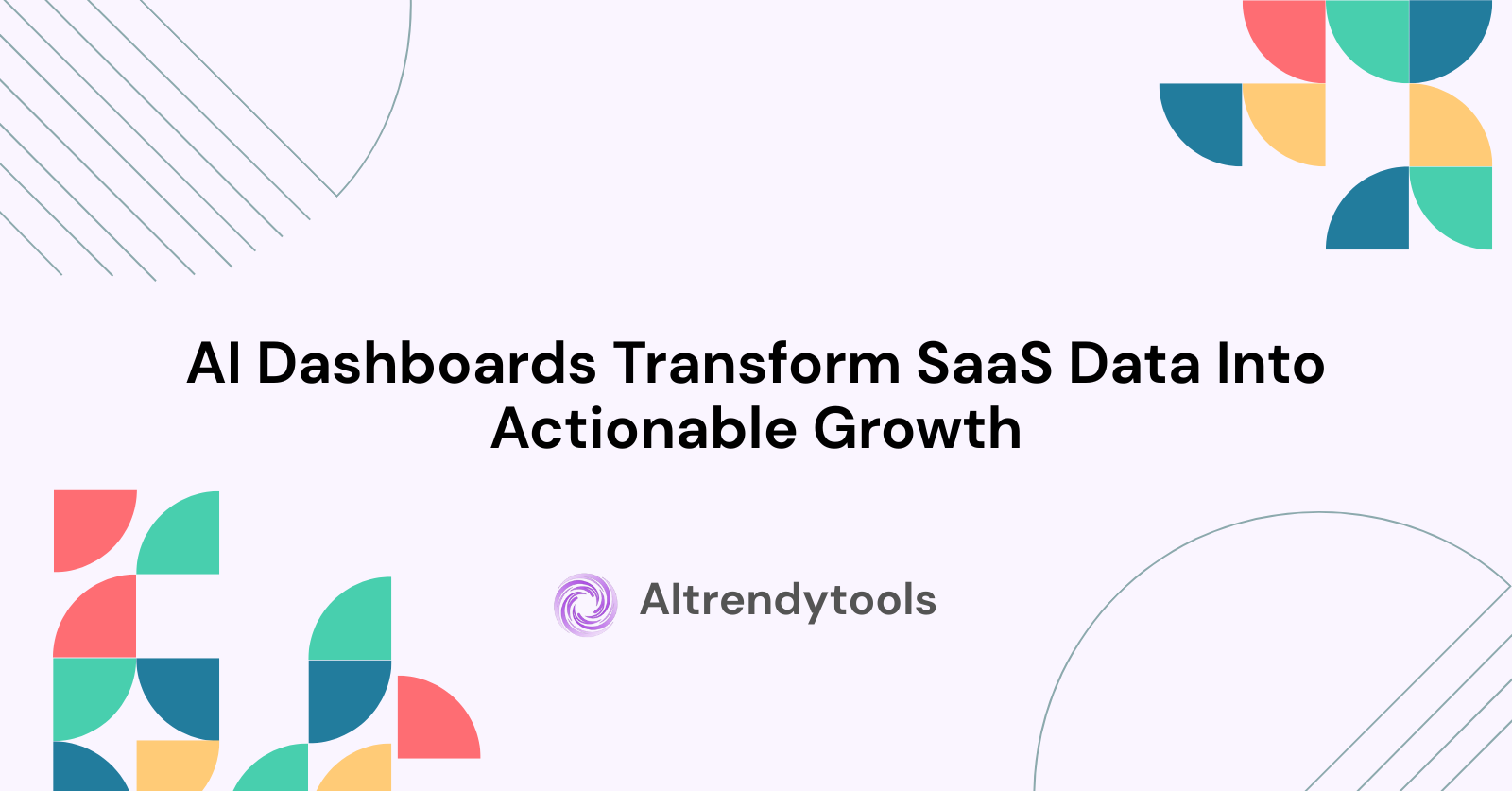🔥 AITrendytools: The Fastest-Growing AI Platform |
Write for usAI Dashboards Transform SaaS Data Into Actionable Growth
Discover how AI-powered dashboards revolutionize SaaS analytics. Learn predictive insights, real-time monitoring & data visualization strategies for growth.
Oct 1, 2025
Data overwhelms most SaaS companies today. Spreadsheets pile up, metrics scatter across platforms, and decision-makers struggle to find meaningful patterns. AI dashboards solve this chaos by transforming raw numbers into visual intelligence.
The shift from traditional analytics to artificial intelligence represents more than a technological upgrade. Modern SaaS businesses generate massive amounts of information every second. Manual analysis cannot keep pace with this volume. AI-powered solutions process complex datasets instantly while revealing hidden opportunities that human analysts might miss.
Understanding AI-Powered Analytics for Modern SaaS
Business intelligence has evolved dramatically over the past decade. Static reports no longer satisfy the demands of fast-moving organizations. Companies need systems that adapt, learn, and predict future trends based on historical patterns.
AI dashboards combine multiple technologies into one cohesive platform. Machine learning algorithms analyze user behavior automatically. Natural language processing enables teams to ask questions in plain English. Predictive analytics forecasts revenue trends before they occur. These capabilities work together seamlessly.
Traditional dashboards display what happened yesterday or last week. AI-enhanced versions tell you what will happen next month. They identify which customers might cancel subscriptions. They predict which features will drive the most engagement. They spot revenue opportunities hiding in complex data relationships.
The competitive advantage becomes clear quickly. Organizations using AI analytics make decisions 5x faster than those relying on manual methods. They respond to market changes proactively rather than reactively. They allocate resources more efficiently based on predictive models rather than guesswork.
Real-Time Data Visualization Transforms Decision Making
Speed matters in subscription business models. Customer churn happens fast. Market conditions shift overnight. Waiting days for quarterly reports puts companies at serious disadvantage.
Real-time analytics dashboards deliver instant visibility into critical metrics. Sales teams see conversion rates update live during campaigns. Product managers track feature adoption the moment users engage. Finance teams monitor MRR changes as transactions complete.
Visual representations make complex patterns immediately understandable. Color-coded charts highlight anomalies requiring attention. Interactive graphs let users drill down into specific segments. Customizable widgets focus attention on metrics that matter most to each role.
Cloud computing infrastructure enables this instant access from anywhere. Mobile optimization ensures executives review performance metrics during commutes. Collaborative features allow entire teams to view identical data simultaneously, eliminating version control issues that plague spreadsheet-based workflows.
The psychological impact of real-time visibility shouldn't be underestimated. Teams feel more connected to business outcomes when they see immediate results from their efforts. This transparency drives accountability naturally without heavy-handed management tactics.
Machine Learning Uncovers Hidden Growth Opportunities
Pattern recognition separates mediocre analytics from exceptional insights. Human brains excel at many tasks but struggle to process millions of data points simultaneously while identifying subtle correlations.
Machine learning algorithms excel precisely where humans falter. They analyze customer lifecycle data across thousands of accounts. They detect usage patterns that predict future upgrades. They identify characteristics shared by customers with highest lifetime value.
Automated data analysis removes weeks of manual work from analytical workflows. Systems continuously monitor subscription metrics without requiring constant human supervision. They flag unusual activity instantly, whether positive trends worth amplifying or concerning drops requiring investigation.
Predictive modeling capabilities transform how SaaS companies approach growth. Instead of reacting to churn after it happens, ML models identify at-risk customers weeks in advance. Instead of guessing which features to build next, algorithms analyze usage data revealing what drives retention most effectively.
The accuracy improves continuously as systems consume more information. Early predictions might achieve 60% accuracy. After processing years of data, the same models often exceed 85% accuracy. This learning capability makes AI systems increasingly valuable over time.
Cross-functional benefits extend throughout organizations. Marketing teams optimize campaigns based on conversion probability scores. Customer success managers prioritize outreach to accounts showing warning signs. Product teams validate roadmap decisions with usage pattern analysis.
Predictive Analytics Drives Proactive Revenue Management
Forecasting revenue accurately remains one of the toughest challenges for subscription businesses. Traditional methods rely heavily on historical trends and educated guesses. Market conditions change rapidly. Customer behavior evolves constantly. Static models fail to capture this dynamic reality.
AI-powered predictive analytics transforms financial planning from guesswork into science. Algorithms analyze dozens of variables simultaneously—seasonality patterns, customer cohort behavior, market indicators, product usage metrics, and economic conditions. They generate probability-weighted scenarios showing best-case, likely, and worst-case outcomes.
Churn prediction capabilities deliver particularly valuable insights for SaaS companies. Losing customers costs far more than preventing departures. Predictive models identify accounts likely to cancel 30-90 days before actual churn occurs. This advance warning enables targeted retention campaigns when intervention still proves effective.
Expansion revenue forecasting helps companies allocate sales resources optimally. ML models score accounts by upgrade likelihood. Sales teams focus efforts where probability of expansion remains highest. This targeted approach generates better results with identical headcount.
Subscription metrics benefit enormously from predictive capabilities. Systems forecast MRR growth trajectories accounting for expected churn, expansion, and new customer acquisition. Finance teams model cash flow scenarios with greater confidence. Executives make hiring decisions based on reliable growth projections rather than optimistic assumptions.
Scenario planning becomes more sophisticated with AI assistance. Leaders explore "what if" questions by adjusting variables and observing predicted outcomes. What happens to churn if we raise prices 15%? How much would improving onboarding reduce early cancellations? These questions get quantitative answers grounded in data patterns.
Self-Service Analytics Empowers Entire Teams
Democratization of data access transforms organizational culture. When only analysts can generate reports, insight generation becomes a bottleneck. Teams wait days for answers to simple questions. Opportunities slip away during approval queues.
Self-service BI platforms equipped with AI capabilities eliminate these friction points. Marketing managers create customer segmentation reports independently. Sales leaders build territory performance dashboards without IT tickets. Product owners analyze feature usage patterns whenever questions arise.
Natural language processing makes sophisticated analysis accessible to non-technical users. Instead of learning SQL syntax, someone simply types "show me churn rate by pricing tier last quarter." The AI interprets intent, queries appropriate databases, and displays results in intuitive visualizations.
Pre-built dashboard templates accelerate time-to-value for new users. Common use cases come configured with relevant metrics and charts. Users customize these foundations rather than building from scratch. This approach balances flexibility with convenience.
Role-based dashboards ensure each team member sees information relevant to their responsibilities. Customer success managers view account health scores and engagement metrics. Executives see high-level KPIs and strategic trend analysis. Engineers track system performance and technical metrics. Everyone accesses tailored views optimized for their decision-making needs.
The cultural shift toward data-driven decision-making happens organically when tools remove barriers to access. People naturally incorporate analytics into daily workflows when generating insights requires seconds rather than days. Questions get answered immediately. Hypotheses get tested rapidly. Iteration cycles accelerate dramatically.
Data Integration Eliminates Silos and Fragmentation
Fragmented data undermines analytical efforts before they start. Marketing metrics live in one platform. Product usage data sits in another system. Financial information resides in accounting software. Customer support interactions hide in ticketing tools. Analyzing relationships across these domains becomes nearly impossible without integration.
Modern AI dashboard platforms excel at connecting disparate data sources. Pre-built connectors link seamlessly with popular SaaS applications—CRM systems, marketing automation platforms, payment processors, analytics tools, support software. Data flows automatically without custom engineering work.
Unified dashboards present holistic views impossible with siloed systems. Marketing teams see how campaigns influence product usage patterns. Finance teams correlate revenue changes with feature adoption rates. Customer success managers view complete account histories spanning all touchpoints.
API-based architectures ensure flexibility for unique data sources. Organizations using specialized tools or custom applications connect these systems alongside standard integrations. Everything feeds into centralized analytical environments.
Data governance features maintain quality and security throughout integrated ecosystems. Access controls ensure sensitive information reaches only authorized personnel. Audit trails track who viewed what data when. Data validation rules catch errors before they corrupt analytical models.
The compound value of integration grows exponentially with each additional data source. Two connected systems provide incremental value. Ten integrated platforms unlock entirely new analytical possibilities. Patterns emerge from cross-system correlations that would remain invisible in isolated databases.
Automated Reporting Saves Hundreds of Hours Annually
Report generation consumes enormous amounts of knowledge worker time. Pulling data from multiple sources, creating visualizations, formatting presentations, distributing to stakeholders—these repetitive tasks drain productivity.
AI-powered automation eliminates manual reporting workflows. Systems generate executive summaries automatically on predetermined schedules. Weekly performance reports arrive in inboxes every Monday morning without human intervention. Monthly board decks update themselves with latest metrics.
Intelligent report builders understand which metrics matter most to different audiences. Executive summaries highlight strategic KPIs with minimal detail. Department-level reports provide operational metrics with deeper granularity. Custom reports accommodate unique stakeholder requirements.
Anomaly detection algorithms flag unusual patterns requiring human attention. When churn spikes unexpectedly, automated alerts notify relevant teams immediately. When a marketing campaign drives exceptional conversion rates, systems highlight this success for wider awareness. This intelligent filtering prevents alert fatigue while ensuring critical information surfaces promptly.
Natural language generation capabilities produce narrative explanations accompanying data visualizations. Instead of just showing a revenue graph, the system writes "Q3 revenue decreased 8% compared to Q2, primarily driven by reduced enterprise customer acquisition and higher-than-expected churn in the SMB segment." These contextual explanations make insights actionable for readers without analytical expertise.
Scheduled distribution ensures stakeholders receive information when needed. Sales teams get daily pipeline reports before morning meetings. Finance teams receive weekly cash flow updates. Executives see monthly strategic dashboards before board presentations. Timing aligns with decision-making cycles.
The cumulative time savings prove substantial. Organizations report reducing reporting work by 60-80% after implementing AI-powered automation. Analysts redirect effort from data compilation toward strategic analysis. Leaders spend less time requesting updates and more time acting on insights.
Customizable Dashboards Adapt to Unique Business Models
Every SaaS company operates differently. Pricing structures vary. Customer segments differ. Success metrics reflect unique value propositions. One-size-fits-all dashboards fail to address these distinct requirements.
Flexible AI dashboard platforms support extensive customization without requiring programming skills. Drag-and-drop interfaces let users arrange widgets showing metrics most relevant to their roles. Color schemes match brand guidelines. Layout options accommodate personal preferences.
Metric calculation engines allow organizations to define KPIs specific to their business models. Traditional SaaS metrics like MRR and CAC form starting points. Companies add custom calculations reflecting unique operational realities. Usage-based billing businesses track consumption patterns. Marketplace platforms monitor transaction volumes and take rates.
Multiple dashboard views serve different organizational purposes. Executive dashboards condense dozens of metrics into scannable overviews. Operational dashboards provide detailed tactical data supporting daily decisions. Strategic dashboards track long-term goals and initiatives.
User permissions ensure appropriate access levels throughout organizations. Executives see company-wide metrics. Department heads view team-specific data. Individual contributors access information relevant to personal responsibilities. This granular control maintains confidentiality while maximizing transparency where appropriate.
Template libraries accelerate dashboard creation for common use cases. Pre-configured views for customer health scoring, financial analytics, marketing performance, and product usage provide strong starting points. Users modify these templates rather than building from zero, dramatically reducing time-to-value.
The balance between standardization and flexibility proves crucial. Too rigid and systems fail to accommodate unique needs. Too flexible and inconsistency undermines comparative analysis. Well-designed platforms strike this balance effectively.
AI-Enhanced Customer Success Reduces Churn
Customer retention drives SaaS profitability more powerfully than any other metric. Acquiring new customers costs significantly more than keeping existing ones. Reducing churn by even small percentages dramatically impacts revenue trajectories.
AI dashboards revolutionize customer success operations through predictive health scoring. Algorithms analyze engagement patterns, support tickets, payment history, feature adoption, and usage trends. They assign health scores indicating likelihood of renewal or cancellation.
Early warning systems alert customer success teams when accounts show concerning signals. Decreased login frequency, reduced feature usage, unresolved support issues, payment failures—these warning signs trigger proactive outreach. Teams intervene before customers reach breaking points.
Segmentation capabilities identify accounts requiring different retention strategies. High-value customers with declining engagement receive white-glove attention. Small accounts showing churn risk get automated re-engagement campaigns. Resources align with revenue impact.
Product analytics integration reveals which features drive stickiness. Customers using specific capabilities show much higher retention rates. Success teams guide new users toward these high-value features during onboarding. This data-driven approach improves outcomes measurably.
Expansion opportunity identification helps teams maximize account value. Usage patterns indicate when customers approach limits requiring plan upgrades. Feature adoption signals readiness for add-on purchases. Timing recommendations optimize upsell conversations.
Automated playbooks standardize best practices across customer success teams. When specific triggers occur, systems recommend proven intervention tactics. New team members follow playbooks while learning. Experienced representatives execute high-touch strategies informed by AI insights.
Scalable Analytics Infrastructure Supports Rapid Growth
Growing SaaS businesses face analytical challenges that compound with scale. Ten customers generate manageable data volumes. Ten thousand customers create petabytes requiring industrial-strength infrastructure.
Cloud-based AI dashboard platforms scale effortlessly alongside business growth. Computing resources expand automatically as data volumes increase. Performance remains consistent whether analyzing ten accounts or ten million. Companies avoid infrastructure bottlenecks that constrain traditional on-premise systems.
Cost efficiency improves with cloud-native architectures. Organizations pay only for resources actually consumed. Storage costs scale linearly with data volumes. Computational expenses align with usage patterns. This variable cost structure proves far more economical than over-provisioning fixed infrastructure.
Data warehouse integration connects AI dashboards with enterprise-grade storage solutions. Snowflake, BigQuery, Redshift, and similar platforms handle massive datasets efficiently. Analytics tools query these warehouses seamlessly, processing complex calculations without performance degradation.
Multi-region deployment ensures low latency for global teams. Data centers located near users minimize delays when loading dashboards. International workforces access identical information with equal speed regardless of geographic distribution.
Security infrastructure protects sensitive business intelligence at enterprise scale. Encryption safeguards data in transit and at rest. Compliance certifications meet SOC2, GDPR, HIPAA requirements. Role-based access controls prevent unauthorized data exposure. Audit logging tracks all system interactions.
API rate limits and resource quotas prevent individual users from degrading system performance for others. Fair usage policies maintain reliability across entire user bases. These safeguards become increasingly critical as organizations scale.
Competitive Benchmarking Reveals Market Position
Understanding performance relative to competitors provides crucial strategic context. Growing 20% annually might seem impressive until discovering that market leaders grew 45%. Revenue metrics feel strong until compared against industry benchmarks.
AI-powered competitive intelligence integrates external data sources with internal metrics. Anonymous benchmark databases aggregate performance data from thousands of companies. Organizations compare their statistics against relevant peer groups filtered by industry, size, and business model.
Metric comparisons span operational and financial dimensions. How does customer acquisition cost compare to similar companies? Where does churn rate fall relative to industry averages? Is expansion revenue percentage above or below market norms? These comparisons highlight strengths to leverage and weaknesses requiring attention.
Performance gaps become immediately visible through comparative visualizations. Color-coded indicators show metrics above, at, or below benchmark ranges. Trend analysis reveals whether gaps are widening or closing over time. This longitudinal perspective proves more valuable than point-in-time snapshots.
Strategic insights emerge from benchmark analysis. If competitor churn rates average 5% but your company experiences 12% churn, customer success initiatives clearly need prioritization. If your CAC matches market averages but competitor LTV ratios exceed yours by 50%, product value propositions require examination.
Privacy-preserving methodologies protect sensitive information while enabling meaningful comparisons. Aggregate statistics reveal industry patterns without exposing individual company data. Organizations gain market intelligence without compromising confidential metrics.
Measuring ROI and Demonstrating Dashboard Value
Technology investments require justification through measurable returns. AI dashboard implementations demand resources—subscriptions, training time, integration efforts. Demonstrating value ensures continued funding and organizational support.
Quantifiable benefits manifest across multiple dimensions. Time savings from automated reporting translate directly to labor cost reductions. Faster decision-making compresses time from insight to action. Improved churn prediction enables early interventions preventing revenue loss.
Productivity metrics document efficiency gains. Teams complete analytical tasks in hours rather than days. Report generation requires clicks instead of manual compilation. Self-service capabilities eliminate waiting for analyst availability.
Revenue impact provides most compelling justification. Reduced churn directly increases annual recurring revenue. Improved expansion success grows average account values. Optimized pricing strategies based on data analysis lift overall profitability.
Cost avoidance represents significant but often overlooked value. Preventing a single large customer cancellation might justify an entire year's dashboard subscription. Avoiding one bad product decision saves months of engineering resources. These prevented losses add substantial economic value.
Adoption metrics indicate organizational embrace of data-driven culture. Dashboard login frequency, report usage rates, and self-service query volumes all measure engagement. High adoption signals that teams find tools genuinely useful rather than viewing them as mandatory burdens.
Success stories from specific initiatives demonstrate concrete wins. Marketing teams attribute campaign improvements to audience insights from AI analytics. Sales leaders credit pipeline forecasting with better quota setting. Product managers point to feature prioritization informed by usage data. These anecdotes humanize statistics while building political support.
The Future of AI Dashboards in SaaS
Innovation in business intelligence continues accelerating. Technologies emerging today will become standard expectations tomorrow. Forward-thinking organizations prepare for these coming capabilities.
Conversational analytics will enable deeper interaction with data through natural dialogue. Instead of clicking through menus, users will have extended conversations with AI assistants. "Show me churn rates" might lead to follow-up questions like "What factors correlate most strongly?" and "Which customer segments show highest risk?" The AI maintains context throughout these exchanges.
Augmented analytics will automate insight discovery that currently requires human analysts. Systems will proactively surface noteworthy patterns without users asking questions. Morning briefings might include: "Enterprise customer engagement dropped 15% this week in the manufacturing vertical—3 at-risk accounts require immediate attention."
Embedded analytics will integrate AI-powered dashboards directly into operational tools teams already use. Sales representatives will see customer health scores within CRM interfaces. Support agents will access usage analytics during ticket resolution. This contextual intelligence improves decision quality at every customer touchpoint.
Mobile-first design will optimize dashboard experiences for smartphones and tablets. Executives will review metrics during commutes. Managers will monitor team performance from anywhere. Touch-optimized interfaces will make exploration intuitive on smaller screens.
Advanced visualization techniques will communicate complex relationships more effectively. Network graphs will show connections between customer segments. Sankey diagrams will illustrate revenue flow patterns. Geographic heat maps will reveal regional performance variations. These sophisticated visualizations will make multi-dimensional data comprehensible.
Ethical AI and explainability will address growing concerns about algorithmic decision-making. Systems will provide clear reasoning behind predictions and recommendations. Users will understand why models suggest specific actions. Transparency will build trust in AI-generated insights.
The convergence of AI dashboards with broader business systems will create seamless intelligence layers throughout SaaS operations. Data won't be something people "go look at"—it will be present in every workflow, informing every decision, visible at every touchpoint. This ambient intelligence will separate leaders from laggards.
Conclusion
AI-powered dashboards represent the future of SaaS analytics. Organizations that embrace these tools gain significant competitive advantages through faster decisions, deeper insights, and proactive strategies.
The technology has matured beyond experimental stages. Proven platforms deliver measurable ROI across customer success, sales, marketing, product, and finance functions. Implementation complexity has decreased dramatically. Cloud-based solutions deploy in weeks rather than months.
The question for SaaS leaders isn't whether to adopt AI dashboards but when. Competitors are already leveraging these capabilities. Market expectations continue rising. Customer demands for data-driven interactions increase steadily.
Starting small often proves most effective. Select one high-impact use case—perhaps churn prediction or financial forecasting. Implement focused solutions demonstrating clear value. Build organizational confidence through early wins. Expand systematically as capabilities prove themselves.
Explore cutting-edge AI dashboard tools and comprehensive SaaS analytics solutions at aitrendytools. Discover platforms that transform raw data into strategic growth engines. The future of business intelligence is here.
🚀 Submit Your Tool to Our Comprehensive AI Tools Directory
Get your AI tool featured on our complete directory at AITrendytools and reach thousands of potential users. Select the plan that best fits your needs.





Join 30,000+ Co-Founders
Related Blogs
DreamFace: #1 AI Face Generator for Realistic Photos
Discover DreamFace, the leading AI face generator creating ultra-realistic portraits. Free & premium tools for creators, gamers & professionals. Try now!
TechMapz Com: 7 Reasons It's Your Best Tech Hub
Discover TechMapz com the ultimate technology hub for gadget reviews, AI trends, cybersecurity tips, and tech news. Explore features that make it stand out in 2025.
Sci Hub: 10+ Free Alternatives to Access Research Papers
Discover Sci Hub alternatives and 10+ legal ways to access research papers free. Complete guide to scientific journals, open access, and academic resources.
Submit Your Tool to Our Comprehensive AI Tools Directory
List your AI tool on AItrendytools and reach a growing audience of AI users and founders. Boost visibility and showcase your innovation in a curated directory of 30,000+ AI apps.





Join 30,000+ Co-Founders

